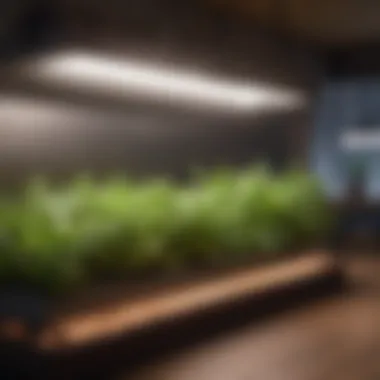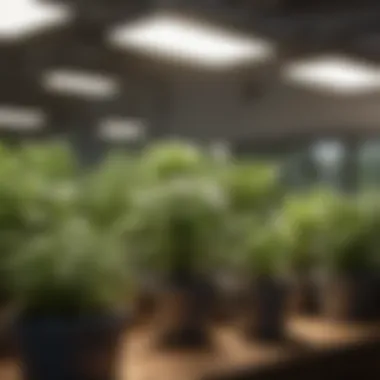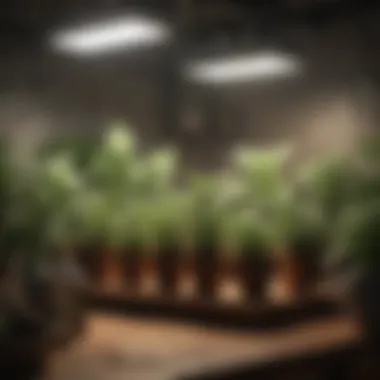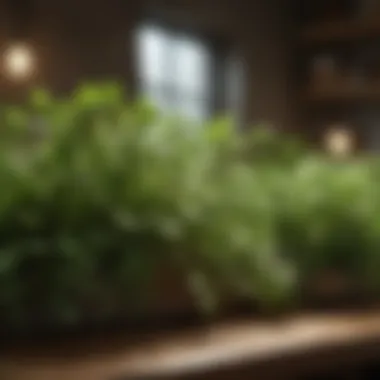Optimal Lighting Solutions for Indoor Herb Cultivation


Intro
Effective lighting plays a crucial role in indoor herb cultivation. Understanding how to select the right light source can significantly impact the growth and flavor of herbs. With a variety of grow lights available, each one offers unique advantages, suited for different herb varieties and growing conditions.
In this article, we will explore optimal lighting solutions tailored specifically for growing herbs indoors. Key factors include energy consumption, light spectrum, and fixture placement intricacies. Readers, whether seasoned gardeners or novice herbalists, will find valuable insights to support their indoor gardening practices.
By the end, homeowners and gardening enthusiasts will possess a well-rounded knowledge base on the best lighting options available for enhancing indoor herb growth.
Prolusion to Indoor Herb Gardening
Indoor herb gardening has gained popularity among home enthusiasts and chefs alike. Having fresh herbs available enhances culinary experiences and promotes creative cooking. Herbs such as basil, mint, and parsley add flavors that elevate dishes. The process of growing herbs indoors is not just about aesthetics; it allows individuals to engage directly with nature.
Understanding the Importance of Light
Light is fundamental to the process of photosynthesis, which is essential for plant growth. Herbs require adequate light to produce energy and grow properly. Different types of herbs have varying light needs, making it crucial for growers to understand these requirements. For instance, basil prefers bright light, while parsley can thrive in lower light conditions.
This comprehensiveness of knowledge helps indoor gardeners to select the correct lighting solutions, ensuring that their herbs remain healthy. Furthermore, the right lighting not only affects growth but also influences flavor and aroma.
Inadequate lighting can lead to leggy plants, with long stems and weak, pale leaves. Being aware of these factors directly impacts one's success in herbs cultivation.
Common Herbs Grown Indoors
Several herb varieties thrive well in indoor conditions:
- Basil: Known for its sweet and aromatic leaves, basil requires plenty of sunlight. It is often a favorite among indoor gardeners.
- Mint: This herb can grow rapidly and adapt to various light conditions. However, it requires regular pruning for optimal growth.
- Chives: With a mild onion flavor, chives thrive best in moderate light and are quite resilient.
- Rosemary: This herb demands bright light and well-drained soil. It adds a distinct flavor to many dishes and makes for an attractive indoor plant.
- Cilantro: Preferring bright but indirect light, cilantro can be grown indoors, providing a fresh taste to many recipes.
The selection of herbs will depend on both personal preference and the light availability in the growing environment. The insights gained from understanding which herbs can flourish under which light conditions will aid in planning a successful indoor herb garden.
Types of Grow Lights
In the realm of indoor herb gardening, the choice of grow lights plays a pivotal role in ensuring the optimal growth and yield of herbs. Grow lights are not merely supplementary light sources; they replicate sunlight, allowing plants to photosynthesize and thrive indoors. Different types of grow lights have unique specifications that cater to diverse needs. Understanding these options is essential for gardeners looking to enhance their indoor cultivation. The right choice can impact not only the health of the plants but also the efficiency of energy usage.
LED Grow Lights
Benefits of LED
LED grow lights have surged in popularity among indoor gardeners for several reasons. One major aspect is their energy efficiency. Unlike traditional lights, LEDs consume less electricity and convert a higher proportion of energy into usable light for plants. This efficiency results in lower energy bills. Additionally, LEDs produce very little heat compared to incandescent lights. This characteristic allows for closer placement to plants without the risk of overheating.
LED lights are also versatile. They come with adjustable spectrums, which means growers can customize light conditions for different growth stages. This flexibility is a significant advantage for indoor herb cultivation. Despite their higher upfront cost, the long-term savings on energy and replacement costs often justify the investment.
Drawbacks of LED
While LEDs offer numerous benefits, there are drawbacks to consider. One key limitation is the initial investment, which can be much higher than traditional lighting options. For some hobbyists, this may pose a barrier to entry. Moreover, not all LED grow lights produce a full spectrum that is ideal for all herbs. Some may only provide specific wavelengths, which might not be suitable for every type of plant. In addition, the technology varies widely, leading to inconsistency in quality across products.


Best Practices for Use
When using LED grow lights, several best practices can enhance their effectiveness. First, maintaining an appropriate distance between the light and the plants is crucial. Placing them too close can lead to light burn, while being too far can inhibit plant growth. It’s also important to adjust light exposure based on the growth stage of the herbs. For example, seedlings often need less intense light than mature plants.
Regularly monitoring plant health can provide clues on whether the light settings are appropriate. Growers should also consider using timers to ensure a consistent light cycle tailored to the specific needs of the herbs.
Fluorescent Grow Lights
Types of Fluorescent Lights
Fluorescent grow lights are another popular choice for indoor herb gardening. They come in various forms, including T5, T8, and compact fluorescent lights (CFLs). T5 fluorescent lights are particularly favored due to their high output and efficiency. These lights have a slim profile, making them easy to install in various spaces, effectively illuminating a larger area.
Fluorescent lights have a broad spectrum as well, allowing for plant growth during different stages. Their lower heat output is another advantage, making them safe to place near young plants. This is essential in preventing heat stress and allowing for better uniformly lighting throughout the garden area.
Advantages of Fluorescent
The key advantage of fluorescent lights is their cost-effectiveness. They are typically less expensive to purchase and operate than LEDs. Furthermore, they provide adequate light without excessive energy consumption. Another positive aspect is their ability to cover a wide area, which is essential when growing multiple herb plants indoors.
Fluorescents also come in different color temperatures, allowing for flexibility based on the specific needs of the plants. Many gardeners appreciate their simplicity and availability. This user-friendly nature makes them a valid choice for both novice and seasoned herb cultivators.
Considerations for Use
Despite their numerous advantages, there are considerations to keep in mind when using fluorescent lights. They generally have a shorter lifespan compared to LEDs. Consequently, regular replacement may increase long-term costs. In addition, fluorescent lights may not provide a spectrum as suitable for flowering as other types of grow lights.
It’s also necessary to ensure proper placement and avoid leaving them on for extended periods. Overexposure can lead to leggy plants that grow too fast without developing healthily. Monitoring light duration is essential to prevent spindly growth and promote a robust herb garden.
Incandescent Grow Lights
Limitations of Incandescent Lights
Incandescent grow lights have seen a decline in use for indoor herb cultivation. One of the main limitations is their inefficiency. These bulbs convert most energy into heat instead of light. Consequently, they are not suitable for extended use in a compact garden setup. The heat produced can be damaging to delicate plants, especially when there is limited space.
Additionally, incandescent lights typically provide a poor spectrum for plant growth. They may not support the photosynthetic needs effectively, leading to suboptimal growth for herbs.
Situations for Use
While incandescent lights are not the first choice for many growers, they can still be useful in specific situations. For instance, they are often employed to provide supplemental warmth during cold months, especially for heat-loving herbs. In such cases, they might be used in conjunction with more effective lighting options.
Another potential use could be in settings where low-cost options are necessary for temporary setups. While not ideal, they can serve as a quick solution for short-term needs. However, for serious indoor herb gardening, their limitations make them a secondary choice.
In sum, when selecting grow lights, understanding the differences between LEDs, fluorescents, and incandescent options will help gardeners make informed choices. This knowledge will increase the likelihood of successful indoor herb cultivation.
Criteria for Choosing Grow Lights


Selecting the right grow lights is crucial for the success of indoor herb cultivation. This decision can significantly impact plant development and yield. The criteria for choosing grow lights involves several elements, including the light spectrum, energy efficiency, and heat emission. Understanding these criteria is essential to maximize both plant health and resource use efficiently.
Light Spectrum Requirements
Plants utilize specific wavelengths of light for optimal growth and development. The spectrum of light affects photosynthesis and influences processes such as flowering and fruiting. Generally, plants require blue light (around 400-500 nanometers) during the vegetative stage for strong leaf and stem growth. In contrast, red light (around 600-700 nanometers) is vital during the flowering stage. Therefore, a grow light should provide a balanced spectrum to cater to these needs.
Some LED grow lights offer full-spectrum capabilities, mimicking natural sunlight and providing both blue and red light. Fluorescent grow lights can also be effective, particularly for smaller or low-light plants. It is crucial for cultivators to ensure their selected lights emit the right wavelengths to meet the growth stages of the herbs.
Energy Efficiency
Energy efficiency is a vital consideration when selecting grow lights, as it influences operational costs and environmental impact. LED lights are known for their high energy efficiency compared to traditional options. They consume less power while providing the necessary light intensity for plant growth. Additionally, LED grow lights often have a longer lifespan, reducing the frequency of replacements. Fluorescent lights also offer better energy efficiency than incandescent lights, but they may not match the longevity of LEDs.
The initial investment in LED technology may be higher, yet the long-term savings on energy bills and replaced bulbs can justify the cost. Understanding the energy requirements of the chosen grow lights allows gardeners to budget effectively and make sustainable choices.
Heat Emission and Control
Heat emission is another important factor in choosing grow lights. Excessive heat can stress plants, leading to poor growth or damage. LEDs typically produce less heat, making them an excellent option for indoor herb gardens. In contrast, incandescent lights generate a significant amount of heat and may require additional cooling methods to regulate temperature.
For indoor cultivators, maintaining a stable temperature is crucial for plant health. Understanding how grow lights emit heat helps make informed decisions. Implementing a monitoring system can help track temperatures and ensure that the chosen lights create a conducive environment for herb growth.
Maintaining the right temperature and light conditions is essential for optimizing indoor herb cultivation.
In summary, each criterion—light spectrum, energy efficiency, and heat control—plays a significant role in the effectiveness of indoor grow lights. Growers need to evaluate these factors carefully to create an ideal environment for their herb gardens.
Setting Up Your Indoor Garden
Setting up your indoor garden is a cricial part of successful herb cultivation. A well-designed setup enables plants to receive optimal light and promotes healthy growth. Specific elements such as the arrangement of grow lights, their height, and how you time their use are key considerations.
The benefits of a proper setup include maximizing light exposure, ensuring consistent growth, and minimizing energy consumption. It is essential to tailor your light placement to the unique needs of the herbs you are growing, as different plants may have varying requirements.
Determining Light Placement
Determining the right light placement is fundamental to the success of your indoor garden. Each type of grow light has different coverage capabilities. The general rule is to place lights 12 to 36 inches above the plants, depending on the type. For instance, LED lights can often be closer than fluorescent lights.
You also want to avoid obstructions that can block light from reaching the plants. Consider the layout of your space, making sure that the grow lights are evenly distributed over the plants. This will prevent some herbs from receiving too much light while others get too little.
Height Adjustments and Mobility
Height adjustments are also crucial for adjusting to the growth stages of your herbs. As plants grow taller, the height of the lights should change accordingly. Many setups allow for easy mobility, either through adjustable hanging mechanisms or movable light stands.
Being able to move the lights up or down will help in maintaining the proper distance, ensuring adequate light exposure. This not only supports healthy growth but also helps save energy, as you do not have to use higher settings than necessary.
Timing and Duration of Light Exposure


Timing and duration of light exposure are just as important as placement and height. Most herbs require 12 to 16 hours of light exposure daily. You can use timers to automate the schedule, ensuring consistency even when you're not around.
Not having appropriate timing might lead to stunted growth or deficiencies. Therefore, investing in a simple timer can significantly enhance the growth rate of your indoor herbs and ensure they thrive.
"Proper light setup is as crucial as watering for the health of your indoor herbs."
Maintenance and Care for Grow Lights
Maintaining grow lights is crucial for the success of your indoor herb garden. Well-maintained lighting systems not only prolong their lifespan but also ensure optimal performance. Several factors come into play when discussing maintenance and care. Keeping grow lights clean can significantly enhance their efficiency, and this translates to better growth for your herbs. Additionally, monitoring these lights regularly helps to assess any potential issues before they become significant problems.
Cleaning and upkeep can reduce the risk of overheating and energy inefficiency. Dust and grime accumulate over time, obstructing light intensity. This can impede photosynthesis and hinder the growth of your herbs. Simple cleaning routines can save you money on energy costs and prevent frequent replacements of lights. Knowing how to care for your grow lights will help you maximize your investment and ultimately your yield.
Regular Cleaning and Upkeep
Regular cleaning is not optional; it is a fundamental aspect of maintaining grow lights. The buildup of dust and other substances can diminish the lights' brightness. This, in turn, affects how well your plants grow. Dust particles not only block light but can also lead to overheating issues. Here are some strategies for effective cleaning of your grow lights:
- Disconnect Lights: Before cleaning, always disconnect the lights to ensure safety.
- Use Soft Cloths: Utilize soft cloths or microfiber materials to avoid scratching the surface.
- Gentle Cleaning Solution: Use a mild cleaning solution, avoiding any harsh chemicals that can damage the light.
- Regular Schedule: It's beneficial to establish a regular cleaning schedule, perhaps every few weeks, to maintain efficiency.
Implementing a consistent cleaning routine can substantially enhance the performance of your grow lights, leading to healthier plants.
Monitoring Plant Growth Progress
Monitoring plant growth is equally essential to successful indoor herb cultivation. Observing how plants respond to various light settings allows gardeners to make informed adjustments. Each herb species may have different light needs, and regular monitoring can help in fine-tuning light exposure.
Consider using the following methods to keep track of plant growth:
- Daily Observations: Spend some time each day observing your plants for signs of growth or distress.
- Growth Journals: Maintain a journal that records growth patterns, flowering stages, or any changes in leaf color. This will help you identify trends.
- Adjust Light Levels: Based on the progress observed, adjust your light height or duration of exposure as necessary.
- Visual Aids: Consider using photos to document growth stages, which can help you recognize patterns over time.
By incorporating monitoring into your gardening routine, you can ensure that your lighting remains optimal, supporting robust herb growth.
Closure
In this article, we have traversed the intricate landscape of lighting solutions tailored specifically for indoor herb cultivation. The importance of selecting appropriate grow lights cannot be overstated, as it directly influences the growth, health, and yield of your herbs. Proper lighting not only enhances photosynthesis but also determines the overall atmosphere of your indoor garden.
Recap of Lighting Options and Techniques
To summarize the lighting options discussed:
- LED Grow Lights: These are energy efficient and versatile, providing a full spectrum of light necessary for various growth stages. They are long-lasting and generate minimal heat, reducing the risk of plant stress.
- Fluorescent Grow Lights: Ideal for seedlings and specific herbs, they are easy to setup and cover a broader area, making them suitable for larger indoor gardens.
- Incandescent Grow Lights: These lights are less recommended due to their high heat output and low efficiency. However, limited use can still be viable in specific situations, especially with plants that may benefit from a warm light.
Light spectrum requirements are essential, ensuring the right wavelengths are present for different herb types. Monitoring energy efficiency is crucial to minimize costs while providing adequate light. Additionally, controlling heat emission is vital in maintaining a suitable growing environment.
Encouragement for Indoor Cultivation
Growing herbs indoors is an achievable goal that many can enjoy. The right lighting setup promotes healthy growth and ensures that your culinary endeavors are not hindered by seasonality or external conditions. Whether you are a seasoned gardener or a novice, understanding your herb’s light needs can greatly enhance your gardening experience.
Incorporating indoor herb cultivation into your home not only provides fresh ingredients but enhances the ambiance of your living space. Start with a modest selection of light fixtures and herbs, and gradually expand your indoor garden as you become more familiar with the intricacies of indoor gardening.
"The key to successful indoor herb gardening lies in understanding and adapting to the unique needs of your plants. Lighting plays a pivotal role in this ecosystem."
As you proceed, approach your indoor cultivation journey with patience and experimentation. Optimal lighting can transform your herbs into lush, aromatic plants that thrive within your walls.







